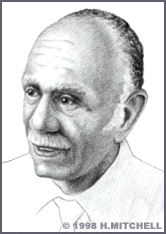Howard Jones
In a career spanning over forty years, Howard S. Jones, Jr. has become one of our nation's most respected inventors and mentors in advanced antenna systems.
Born in 1921 in Richmond, Virginia, Jones did not discover his interest and talent for science until entering Virginia Union University at the encouragement of his mother. Upon earning a BS in mathematics and physics there in 1943, Jones decided to go into engineering. With World War II underway, the country needed engineers, and Jones moved to Washington, D.C. to work for the National Bureau of Standards (now the National Institute of Standards and Technology).
Although Jones served as a Signal Corps specialist in Japan and was offered an officer's position by the Army, he chose to return to research after the war at an Army laboratory in Maryland. At the time, it was directed by Harry Diamond, who had specialized in ordinance technology at the National Bureau of Standards (NBS).
It was at the Harry Diamond Laboratory (now part of the U.S. Army Research Lab) in Adelphi, Maryland that Jones rose to prominence as a specialist in antenna systems for weapons fuses. After arriving, Jones was encouraged by his supervisors, who said, "We want you to invent as prolifically as Jacob Rabinow," who had also worked in ordinance technology and was already a living legend at NBS. Jones responded to this challenge by producing roughly one patent per year throughout the 1950s, 1960s and 1970s, including the radar fuse antenna systems that were used in most of the missiles produced by the Army during that time.
Jones' first patent was for an "Antenna Testing Shield" (patent #3,029,430). Engineers still use this hood to test a weapon's fusing system in conditions that simulate flight through free space. Jones' greatest contribution to the development of weapons technology, involving a number of his patents, was the "conformal" antenna array.
Missiles, which for the purposes of speed, accuracy, and reliability must be aerodynamic, require antennas for long-range electronic detonation. Jones' breakthrough was to build antenna arrays of copper wire and electronic circuits into the casing of a missile. Jones managed to eliminate the need for spindly appendages that created drag during a missile's flight, without exceeding specifications of weight and size.
Jones' lightweight conformal antenna arrays have been used in weapons, like the Patriot missile, and spacecraft, like the Voyager, and have set the precedent for the "smart skins" developed for radar-evading aircraft like the "stealth bomber." Meanwhile, Jones continued to invent and problem-solve in the field of antenna technology and has shared his expertise with students, small businesses, and government agencies throughout the country. Jones' younger colleagues cite his enthusiasm for the practical, nuts-and-bolts elements of their craft, as well as his encouragement that they be true professionals in their field.
Jones retired in 1980 and has a total of 31 patents to his credit. He also won the Institute of Electrical and Electronic Engineer's Harry Diamond Award in 1985. His numerous other honors include an honorary degree from Trinity College in Hartford, CT, which he received in 1997, and election into the National Academy of Engineering in 1999. Perhaps the greatest testimony to his achievements is that, despite the tremendous technical and financial resources committed to the defense industry, many of his ideas and designs are still in use. Howard S. Jones, Jr. has certainly succeeded in following his mother's advice: "Never look back. Always look ahead and try to improve things."
He died on February 26, 2005 at the age of 83.


